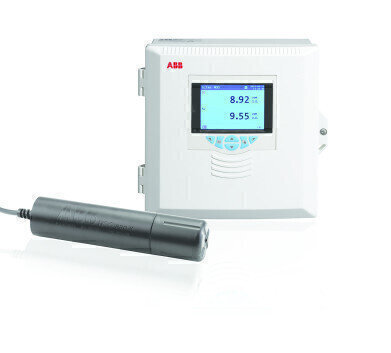Water/wastewater
New Optical Sensor Cuts the Costs of Dissolved Oxygen Measurement
Oct 22 2015
Problems associated with traditional dissolved oxygen sensing systems can now be eliminated using ABB’s (UK) new optical dissolved oxygen sensing system. Consistent, reliable and accurate, it can help operators to realise significant savings through reduced energy consumption and maintenance.
Comprised of the ADS430 sensor and multi-channel transmitter, the system provides the highest levels of stability and accuracy for dissolved oxygen measurement. The ADS430 optical dissolved oxygen sensor uses Rugged Dissolved Oxygen (RDO)* optical technology for measuring dissolved oxygen in the most demanding process environments. The RDO technology, which has been approved by the U.S. Environmental Protection Agency (EPA), uses the dynamic luminescence quenching technique. Comprised of a sensor and multi-channel transmitter, it works on the frequency domain method and provides the highest levels of stability and accuracy for dissolved oxygen measurement.
The patented signal processing within the sensor enables it to respond to changes in process conditions up to five times faster than other optical systems, allowing maximum process savings through improved control.
The robust design of the sensor enables it to withstand the problems that can affect conventional membrane-based sensors, such as abrasion, fouling or poisoning. Constructed from inert, non-corrosive materials, it is suitable for use in high salinity environments. The sensor lumiphore is not affected by photobleaching or stray light. The sensor itself is also immune to the effects of sulfides, sulfates, hydrogen sulphide, carbon dioxide, ammonia, pH, chloride and other interferences that can affect membrane-based sensors.
The use of the dynamic luminescence quenching principle means that the sensor is not susceptible to drift, removing the need for frequent maintenance.
A key benefit of the system is its simplicity. ABB’s EZLink plug and play technology automatically connects the transmitter and sensor, with no need for wiring or complicated configuration.
Set-up is straightforward, with a user friendly HMI and clear menus making it easy to set parameters and view diagnostic information.
Available in two or four channel versions, the Aztec AWT440 universal transmitter can be connected to up to four ABB digital sensors, enabling monitoring at multiple points without purchasing and installing separate transmitters.
This simplicity also extends to the sensor itself, which features a smart sensing cap with automatic setup. The SmartCap comes pre-loaded with factory calibration coefficients, serial number, lifetime indication, and manufacture date which are automatically uploaded to the sensor, eliminating the time normally required for set-up. By automatically prompting the user when replacement is due, the SmartCap also removes the risk of unexpected sensor failure.
The SmartCap is capable of up to 24 months of continuous operation, greatly reducing the requirement for maintenance. When the cap does need replacing, it will be as easy as the original installation – the calibration details will be pre-loaded and the transmitter will automatically recognise the new sensor.
When cleaning is necessary, it can be cleaned and redeployed without calibration, saving time and cost and eliminating disruption to measurement.
For high-fouling applications, the sensor can be automatically cleaned using ABB’s auto-cleaning system. This system periodically injects a high pressure burst of air across the sensor surface to remove any fouling.
All measured data is stored in the AWT440 transmitter’s internal memory, together with event log and configuration data. In total, up to 300 days’ worth of process data can be stored, in addition to the last 10 data log and event log files and eight configuration files within its internal memory.
The transmitter's event log files contain audit log, alarm log, diagnostic log and calibration log data that is time and date stamped, providing the operator with full audit trail capability.
Various options are available for remotely accessing data held within the transmitter. An Ethernet option enables measurement readings and active diagnostics data to be accessed via a PC. Profibus DP V1.0 or Modbus RS485 communications provide the added choice of accessing data via a distributed control network. The inclusion of SD and USB portals also enables users to securely store data on portable devices for transfer to a PC for analysis using ABB's DataManager Pro data review software.
With a range of installation options, the ABB optical dissolved oxygen system can be used in a wide variety of applications, from large-scale municipal and industrial waste water treatment plants through to food and beverage production processes. Options include dip mount systems, floating ball systems and chain mount immersion systems for open tank and channel installations, as well as a flow-through system for panel mount systems.
Digital Edition
IET 35.2 March
April 2025
Air Monitoring - Probe Sampling in Hazardous Areas Under Extreme Conditions - New, Game-Changing Sensor for Methane Emissions - Blue Sky Thinking: a 50-year Retrospective on Technological Prog...
View all digital editions
Events
Apr 30 2025 Ankara, Turkey
May 06 2025 Nuremberg, Germany
May 10 2025 Karachi, Pakistan
May 11 2025 Vienna, Austria
May 11 2025 Seoul, South Korea







_(4427399123)-(2).jpg)

.jpg)









